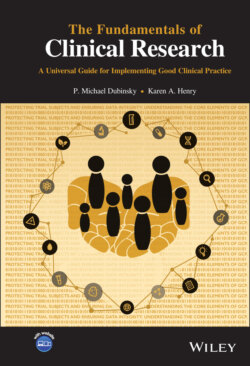Читать книгу The Fundamentals of Clinical Research - P. Michael Dubinsky - Страница 30
2.6 Regulatory/Competent Authority Organizations
ОглавлениеThe second element in the regulatory environment matrix is the regulatory or competent authority. The regulatory authority is charged or assigned the task of implementing and enforcing the laws and regulations, i.e. regulatory requirements. ICH E6(R2) highlights the roles of application review and inspection for regulatory authorities. In fact their responsibilities include other tasks for example, inspecting clinical trial activities, enforcing the requirements, and educating regulated entities. Understanding the roles and responsibilities of the regulatory authority, how they are organized, and what their approaches are to implementation of the applicable laws and regulations adds value and is essential to conducting clinical trials in conformance with GCP.
There are internet resources which provide listings and links to many of the global regulatory authorities responsible for drug/device regulation in general and the oversight of clinical trials in particular. It is likely you have already accessed many of the webpages for global regulatory authorities.
While the US FDA does not serve as the single model for global regulatory authorities it represents one of the best known and seasoned regulators. If we look back at the introductory chapter you will note that many of the key events associated with the evolution of clinical trial and pharmaceutical product regulation took place in the United States and the growth of clinical trial regulation is directly linked to the growth of the US FDA as an organization.
Using the FDA’s review process of applications for permission or authorization to conduct clinical trials does provide a somewhat generic blueprint for application review.
First a trial sponsor submits an application which is assigned to one of the three FDA headquarters’ offices:
1 Center For Drug Evaluation and Research (CDER) – INDs
2 Center for Biologics Evaluation and Research (CBER) – INDs and IDEs
3 Center for Devices and Radiological Health (CDRH) – IDEs
Each of the FDA Centers has a scientific technical group assigned to receive, review, evaluate, and decide on acceptability of the applications submitted.
There are procedural aspects of the review process that must be followed including timeframes for decisions. It is the responsibility of the FDA and all regulatory agencies to determine whether there is adequate information from nonclinical as well as clinical information about an investigational product to support the plan for the proposed clinical trial. Information about the manufacturing aspects of the investigational product as well as details about the investigation plan and the ethics review process is also included in the application. Part of the authorization decision by the FDA is determining whether the ethics review process for the planned study is already completed or a commitment is made to do so before enrolling any subjects. If a proposed trial is approved the sponsor is advised and periodic reports will be required. The number of trial sites along with the proposed number of subjects is, or becomes part of the application file as the study progresses.
In the European Union, the application from the sponsor is evaluated by the individual member state’s health authority. So if trials are to be conducted in five of the member states applications must be submitted to each. There is no common application forum as with the US FDA using the IND format. This lack of a central clinical trial authorization process is an issue that is being addressed by EU authorities and is expected to be resolved with the advent and full implementation of the European Clinical Trial regulation [5]. The European Medicines Agency (EMA) does play a role in facilitating coordination among the member states for clinical trial matters, e.g. inspections, but it does not serve as a central reviewer providing mutually accepted decisions. This text will not attempt to outline the regulatory review processes for all regulatory authorities/competent authorities but rather to point out that they exist and are the players in the regulatory environment.
